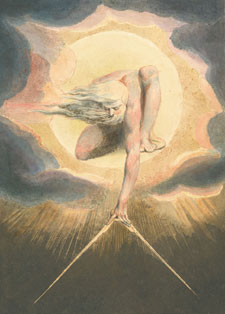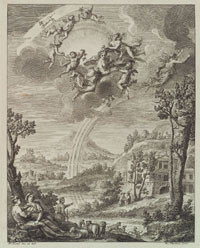Humanities and the Culture of Science
 “The Ancient of Days,” frontispiece to William
“The Ancient of Days,” frontispiece to William
Blake, Europe:
A Prophecy (Lambeth,
1794) –
Henry W. and Albert A. Berg Collection of
English and American Literature, NYPL
Alexander
Pope’s famous couplet eulogizing Newton – “Nature and Nature’s
Laws lay hid in Night. / God said, Let Newton be! and All was Light.” – encapsulates
the challenge that Newton’s success posed for men of letters and artists
alike. On the one hand, his transcendent genius necessitated a view of him
akin to that of a poet or a painter, thus insinuating a more prominent role
for reason in the act of creation. On the other hand, since Newton had reconstituted
nature, those who versified or painted it found themselves compelled to become
more philosophical in their approach and training – if poetry and art
were to maintain their age-old objective to instruct as well as to please.
 Plate from James
Thomson, The Seasons
Plate from James
Thomson, The Seasons
(London, 1730) – Rare Books
Division,
NYPL
What
ensued was half a century of ambiguity and tension between poetic license and
the demands of a (quantified) nature, resolved only with the advent of Romanticism
in the late eighteenth century. The Romantics sought to remove poetry and art
from under the umbrella of science, substituting mysteries and emotions for
laws and reason. To this end, Newton was excoriated as the chief culprit who
had “decomposed the rainbow” (Shelley) and bequeathed that “single
vision” that had deadened nature (Blake).


